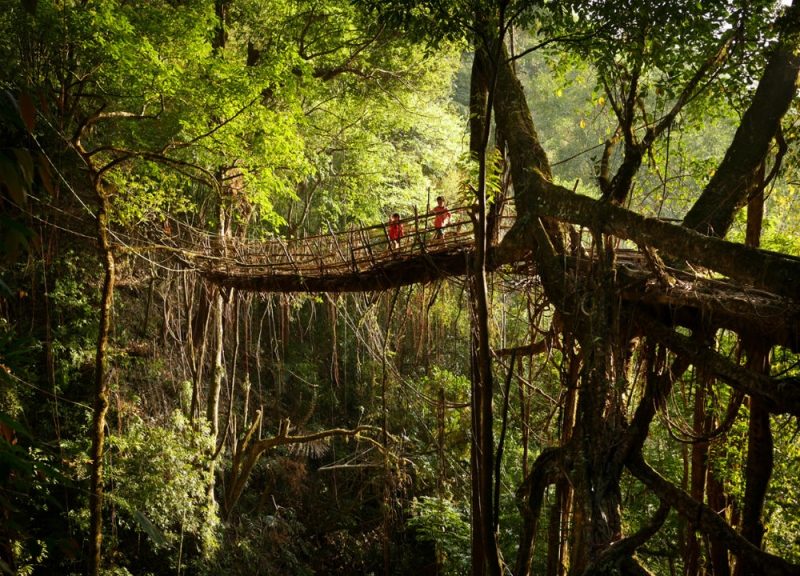
Ancient traditions and modern Bollywood fantasies intertwine in India. Banana leaf huts in the villages of Rajasthan and skyscrapers propping up the sky of New Delhi. Colorful rituals in Hindu temples and high information technology in Bangalore. But the most interesting thing is the amazing customs and places that India is famous for.
I want to go to India!
1. Skeleton Lake (Roopkund, Uttarakhand)
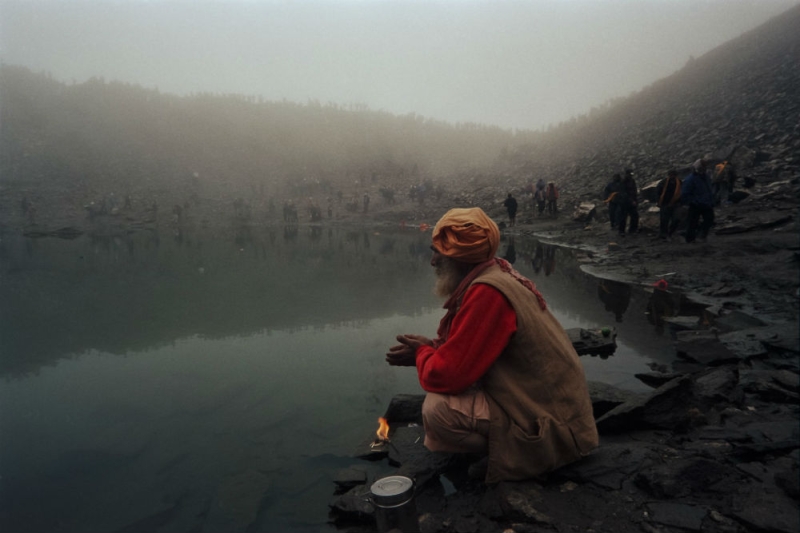
Photo: Nick Fleming Photographer
In 1942, a British gamekeeper in Roopkund made an amazing discovery. At an altitude of 5 thousand meters in a frozen lake, he discovered a large accumulation of human skeletal remains. What these people were doing there and what killed them became the main mystery for scientists in the following decades.
Many speculations have been made: an epidemic, a sudden avalanche, and even ritual suicide of cult followers. In 2004, with the advent of technologies allowing detailed analyzes, the situation began to become clearer.
It turned out that all the bodies date back to 850 AD. and are divided into two groups: one of them is family or relatives, the other is shorter, local residents. Rings, spears and bamboo sticks were also found along with the bones. Experts suggest that these were pilgrims and local porters. All the people died from being hit in the head by some round objects. But what was it?
The Himalayan women have an ancient traditional song about an angry goddess who rained down death on intruders in her mountain sanctuary in the form of hail, “hard as iron.”
After much research, scientists came to the same conclusion: all 200 people died from a sudden and unusually large hail – the size of a soccer ball (about 23 cm). In the open space of the ill-fated valley, the travelers did not have the slightest chance to hide. The remains lay in the frozen lake for 1200 years before the disaster was revealed to the world.
2. Twin City (Kodinhi, Kerala)
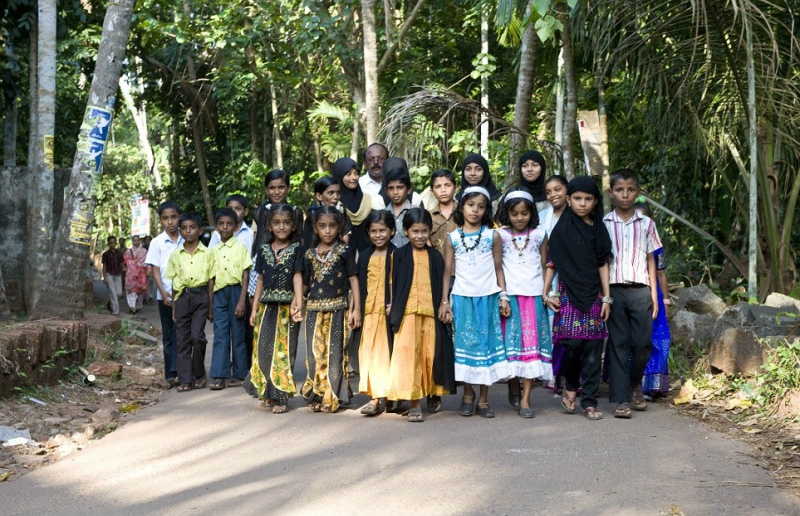
Photo : Niklas Halle’n/Barcroft Media
At first glance, this village is similar to thousands of others all over India. With one difference – twins are born here too often. For every 1000 births, 45 are twins.
The birth of twins is generally quite rare. Statistics say that only 3 out of 100 births result in two babies. In India, this happens even less often – 1 pair in 4 thousand births.
The phenomenon of this area was discovered in 2008, when it was estimated that over the past 25 years more than 250 pairs of twins were born here. Doctors believe that there are even more of them in the region.
It has been suggested that this is due to the polluted water in the village. But this hypothesis was quickly abandoned – no significant contamination or anomalies were found, and most of the children were completely healthy.
The solution to the strange pattern has not yet been found, but a tourist route to the town has already been laid – to the mutual joy of local residents and travelers.
3. Krishna’s City and Widow’s Shelter (Vrndavana, Uttar Pradesh)
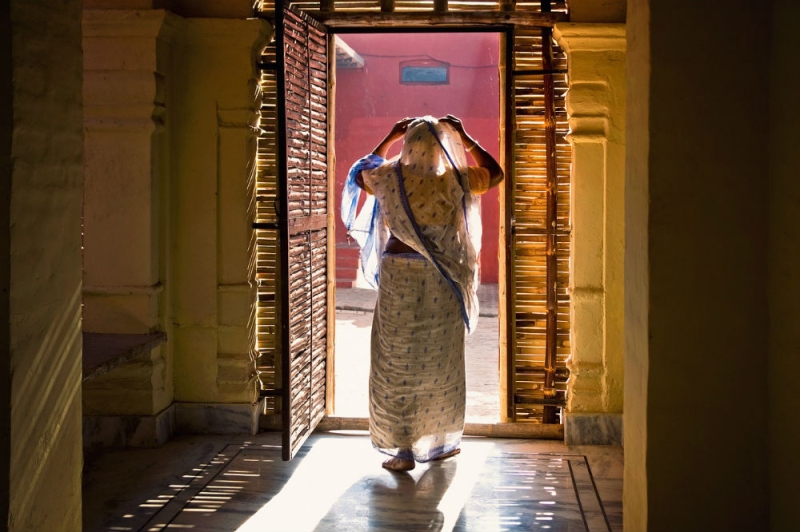
A few hours’ drive from the capital lies one of the holiest Hindu sites. According to legends, it was in the forest of Vrindavan that the blue-skinned dancing god Krishna was born, appearing in the guise of a shepherd with a flute and flirting with cute gopi cowherd boys. There are several thousand temples in the city, songs dedicated to Krishna and his beloved Radha are heard day and night, and it seems that the whole air is saturated with love. Thousands of pilgrims flock here every year, and many even come specifically to die – like Varanasi, the holy city promises a way out of samsara and an end to the chain of births and suffering.
But Vrindavan also has another glory. Destitute, lonely or abandoned women flock here from all over the country. All of them are widows. According to ancient tradition, it is generally accepted that they somehow angered the gods, since they sent such a curse on the family. A widowed woman becomes an outcast – superstitious relatives try to get rid of the burden, passers-by avoid a woman in a white sari. A widow is supposed to observe strict fasting for the rest of her life and deprive herself of all entertainment and joy – so as not to feel the thirst for life.
Today, among educated Indians in big cities, this harsh tradition is hardly observed. A woman whose husband has died often moves into the house of her children or relatives. Not everyone wears a white sari and limits themselves to sweets.
However, in the villages everything remains the same. And hundreds of women of different ages – both very young and old – flock to Vrindavan every year to find refuge here.
They live in ashrams and temples – they sing bhajans and mantras (religious chants), do some work for the locals, but most often live on the alms of pilgrims.
It is not known exactly how many widows live here today – according to various estimates, from 2 to 10 thousand. All these women have no prospect except to live according to the harsh law of Indian society and pray for a speedy end to this life.
Despite all the efforts of volunteers and caring people from the educated classes trying to somehow change the situation, the flow of women has not yet stopped.
4. The wettest place on Earth and living bridges (Mawsynram, Meghalaya)
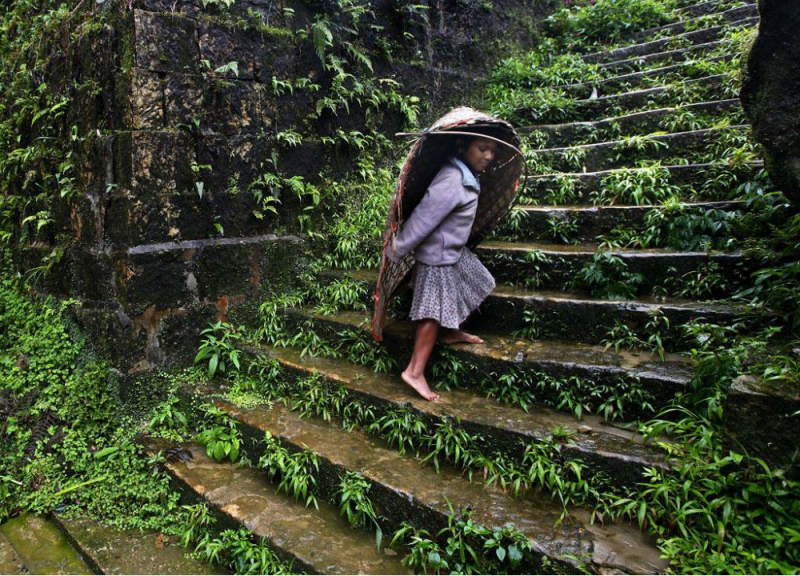
Photo: Veg Momos
“Land of the clouds” or “abode of rain” is the name of a village in the state of Meghalaya. According to the Guinness Book of Records, this is the wettest place on our planet. From June to September, the monsoons bring moisture here from the Bay of Bengal. It condenses over the plateau in the Eastern Khasi Mountains and falls in heavy rainfall, literally flooding the surrounding area.
It would seem – what’s special about the rains? But these rains bring 11,871 mm of water annually. For comparison, in St. Petersburg, “the rainiest city in Russia,” about 662 mm falls per year, and in London – 554 mm.
Local residents working outdoors have come up with their own escape from the incessant downpour. They weave huge “umbrellas” from bamboo and banana leaves, which are held on their heads while their hands remain free.
Surprisingly, when the season ends, there comes a time of severe drought, during which there is a shortage of drinking water and people have to travel long distances to replenish supplies.
But these places are famous not only for rain. 16 km from Mawsynram there is the city of Cherrapunji, which ranks honorably second in humidity. Living bridges made from intertwined tree roots grow here. Ficus elastica (rubber tree) is a distant relative of the ficus trees on our windowsills.
A long time ago, local residents noticed the unique power and elasticity of the roots of this tree and, with their help, solved the problem of crossing rivers in the vicinity of the city.
It takes 10 to 15 years to build a 30 meter long bridge. Over time, the bridges grow and become stronger, so that they can support more than 50 people at a time. Some of the “living bridges” used daily by residents and tourists are over 500 years old.
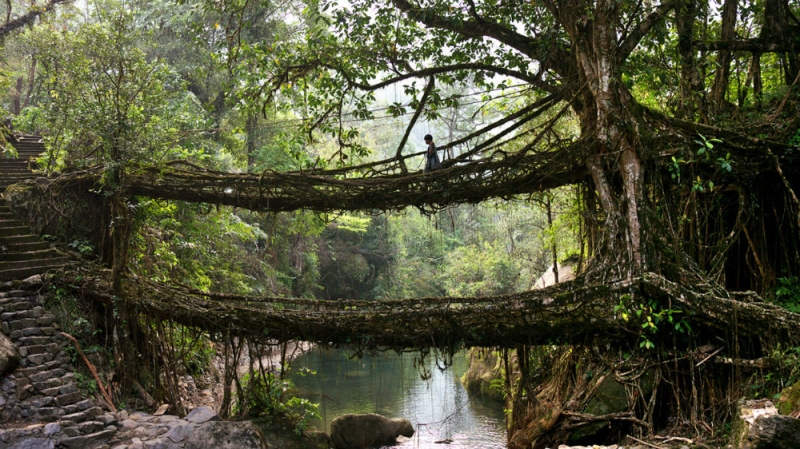
Photo: © Amos Chapple
Here, in the village of Nongiat, there is a one-of-a-kind two-story “viaduct”, vaguely reminiscent of the Tower Bridge in London. True, in order to walk along it, you will have to work hard and overcome several hours of mountain trekking – the village is located at an altitude of more than 2 thousand meters.
5. Karni Mata Rat Temple (Denshok, Rajasthan)
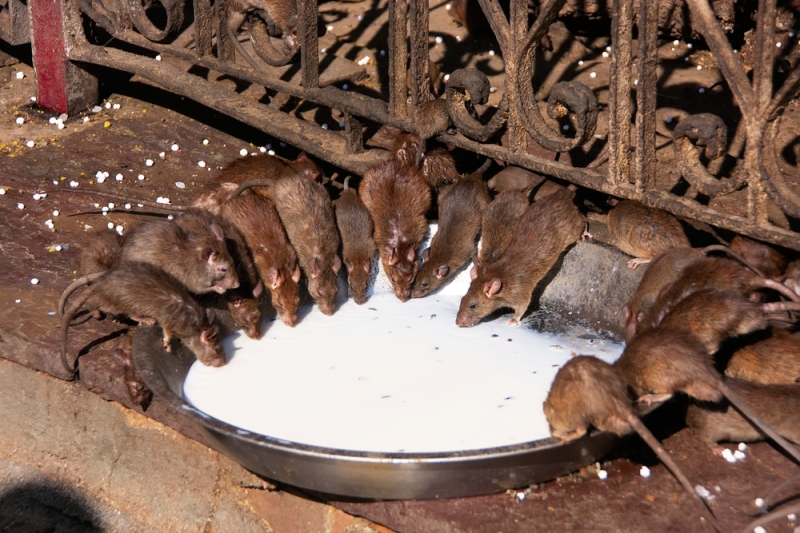
Photo : depositphotos.com
The temple is home to more than 20,000 rats, including several albino rats, which are revered as especially sacred. Pilgrims from all over India come to receive blessings from the animals. Many people try to share lunch with rats or carry rat excrement in their pockets. How did it happen that rats took such an honorable position?
Legend has it that in the 15th century, an unusual woman lived in these parts, nicknamed Karni Mata (“mother of Karni”), – incarnation of the warrior goddess Durga. She preached, walked around villages with her followers, and even blessed rulers for their conquests. In Denshok, her adopted son drowned while trying to drink water from the river. Karni Mata asked the god of death Yama to resurrect the boy, but he refused her. Then she proclaimed that the boy and all the men of her caste would never go to Yama, and after death they would take the form of rats and live in this temple until their next rebirth.
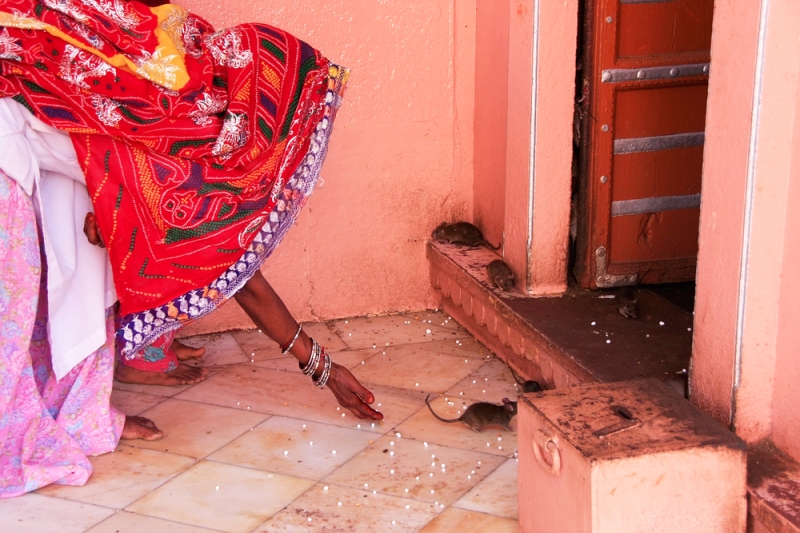
Rats, affectionately known here as “kabbas” (“little children”), fed grain, milk and coconut shells. The water in the bowls from which rats drink is considered holy and is believed to bring happiness to pilgrims. Particularly zealous believers try to eat some of the “sacred” food left after the rat meal. It’s hard to believe, but for all this time not a single acute intestinal disease has been recorded here.
In the temple you should only walk barefoot and try not to harm the rodents in any way. To protect against cats and other predators, the temple space is surrounded by a special net. If a sacred animal is killed, it should be replaced with a figurine made of gold or silver, equal in weight and size. The temple already houses several dozen similar figurines.
A large family of rats is looked after by villagers from the Depawat clan, which numbers 513 people. They work in shifts according to the lunar cycle and live permanently in the temple, considering this duty their calling in life.
Preview photo: © Amos Chapple

